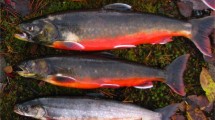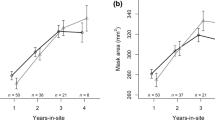Summary
Hamilton and Zuk (1982) proposed that the quality of male showy traits reflects genetically-based resistance to parasites and can be used by females to select mates that are less prone to parasitic attack. The hypothesis requires that a particular state of a variable showy trait should be associated with parasite infection. We tested this idea with a population of western fence lizards, Sceloporus occidentalis, infected with the malarial parasite, Plasmodium mexicanum. Ventral color pattern is strongly dimorphic in fence lizards and varies greatly among males in this population. Malaria-infected males exhibited significantly more black and less pale on their ventral surface than did noninfected males of similar body size. This difference was not a function of differing ages of infected and noninfected animals of the same body size. However, logistic regression demonstrated that females using male ventral color as a gauge of infection status would only marginally improve their chance of choosing a noninfected lizard over random selection of mates.
Similar content being viewed by others
Refereces
Afifi AA, Clark V (1984) Computer-Aided Multivariate Analysis. Wadsworth, Belmont, CA
Andrews R (1982) Patterns of growth in reptiles. In: Gans C, Bough H (eds) Biology of the Reptilia, vol 13. Academic Press, New York, pp 273–320
Ayala SC (1970) Lizard malaria in California; description of a strain of Plasmodium mexicanum, and biogeography of lizard malaria in western North America. J Parasitol 56:417–425
Borgia G (1986) Satin bowerbird parasites: a test of the bright male hypothesis. Behav Ecol Sociobiol 19:355–358
Bromwich CR, Schall JJ (1986) Infection dynamics of Plasmodium mexicanum, a malarial parasite of lizards. Ecology, 67:1227–1235
Carpenter CC (1962) Patterns of behavior in two Oklahoma lizards. Am Midl Nat 67:132–151
Carpenter CC, Ferguson B (1977) Variation and evolution of stereotyped behavior in reptiles. In: Gans C (ed) Biology of the Reptilia, Vol 7. Academic Press, New York, pp 335–554
Cooper WE, Burns N (1987) Social significance of ventrolateral coloration in the fence lizard, Sceloporus undulatus. Anim Behav 35:526–532
Darwin CR (1871) The Decent of Man and Selection in Relation to Sex. Murray, London
Dawkins R (1986) The Blind Watchmaker. W.W. Norton, New York
Duvall D (1979) Western fence lizard, Sceloporus occidentalis, chemical signals. 1. Conspecific discriminations and release of a species-typical visual display. J Exp Zool 210:321–326
Fox D (1953) Animal Biochromes and Structural Colors. Cambridge University Press, Cambridge
Freeland WJ (1976) Pathogens and the evolution of primate sociality. Biotropica 8:12–24
Hamilton WD (1982) Pathogens as causes of genetic diversity in their host populations. In: Anderson RM, May RM (eds) Population Biology of Infectious Diseases. Springer, Berlin Heidelberg New York, pp 269–296
Hamilton WD, Zuk M (1982) Heritable true fitness and bright birds: a role for parasites? Science 218:384–387
Kimball FA, Erpino M (1971) Hormonal control of pigmentary sexual dimorphism in Sceloporus occidentalis. Gen Comp Endocrinol 16:375–384
Kirkpatrick M (1986) Sexual selection and cycling parasites: a simulation study of Hamilton's hypothesis. J Theor Biol 119:263–271
Lewontin RC (1966) On the measurement of relative variability. System Zool 15:141–142
Noble GK (1934) Experimenting with the courtship of lizards. Nat Hist 34:3–15
Partridge L, Harvey P (1986) Contentious issues in sexual selection. Nature 323:580–581
Rau ME (1983) Establishment and maintenance of behavioural dominance in male mice infected with Trichinella spiralis. Parasitology 86:319–322
Read AF (1987) Comparative evidence supports the Hamilton and Zuk hypothesis on parasites and sexual selection. Nature 328:68–70
Ressel S (1988) Sexual color dimorphism, sexual selection, and malarial parasitism in the western fence lizard, Sceloporus occidentalis. Thesis, University of Vermont, p 59
Schall JJ (1983a) Lizard malaria: parasite-host ecology. In: Huey RB, Schoener TW, Pianka ER (eds) Lizard Ecology: Studies on a Model Organism. Cambridge: Harvard University Press, Cambridge, pp 84–100
Schall JJ (1983)b Lizard malaria: cost to vertebrate host's reproductive success. Parasitology 87:1–6
Schall JJ (1986) Prevalance and virulence of a haemogregarine parasite of the Aruban whiptail lizard, Cnemidophorus arubensis. J Herpetol 20:318–324
Schall JJ, Dearing MD (1987) Malarial parasitism and male competition for mates in the western fence lizard, Sceloporus occidentalis. Oecologia 73:389–392
Schall JJ, Sarni GA (1987) Malarial parasitism and the behavior of the lizard, Sceloporus occidentalis. Copeia 1987:84–93
Schall JJ, Bennett AF, Putnam RW (1982) Lizards infected with malaria: physiological and behavioral consequences. Science, 217, 1057–1059
Smith HM (1946) Handbook of Lizards. Cornell University Press, Ithaca
Stebbins RC (1966) A Field Guide to Western Reptiles and Amphibians. Houghton Mifflin, Boston
Zahavi A (1975) Mate selection — a selection for a handicap. J Theor Biol 53:205–214
Zar JH (1984) Biostatistical analysis, 2nd Edition. Prentice-Hall, Englewood Cliffs
Zuk M (1984) A charming resistance to parasites. Nat Hist 93:28–34
Zuk M (1987) The effects of gregarine parasites, body size, and time of day on spermatophore production and sexual selection in field crickets. Behav Ecol Sociobiol 21:65–72
Author information
Authors and Affiliations
Rights and permissions
About this article
Cite this article
Ressel, S., Schall, J.J. Parasites and showy males: malarial infection and color variation in fence lizards. Oecologia 78, 158–164 (1989). https://doi.org/10.1007/BF00377151
Received:
Issue Date:
DOI: https://doi.org/10.1007/BF00377151




